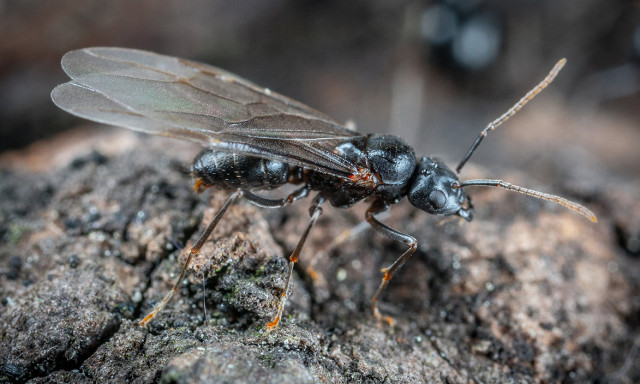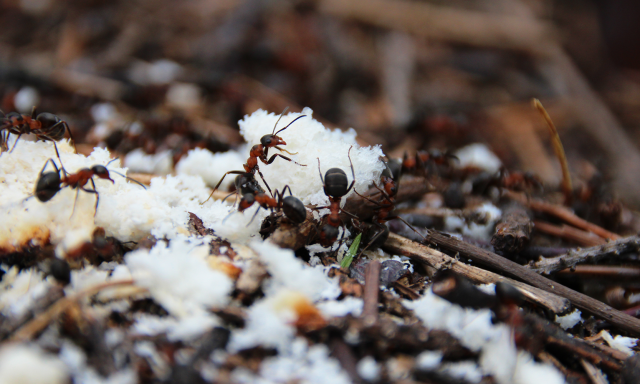Ant Super Colonies
Ants are among the most successful insects; inhabiting all the world’s continents except Antarctica. Most species, and all the pest species are social insects. That is they form colonies of co-operating individuals. The level of co-operation differs between species and there are parallels between the co-operation of ants in an ant colony and the cells in the body of individual organisms. In some ways, it can be useful to think of ant colonies as superorganisms when considering their behaviour. Understanding ant behaviour is central to understanding the best ways to control and get rid of pest ants.
Simple ant colonies may comprise sister workers and one fertile queen. The workers are little differentiated and all carry out a range of tasks within the nest. Workers in simple colonies may be able to produce eggs, but for the good of the colony on a whole, when they do, other workers will capture the ant and hold her until her ovaries reduce and eggs are not produced. This ensures the colony shares a close genetic family relationship. It is this close genetic relationship that explains the altruism of non-breeding worker ants. This parallels the co-operation between cells in simple organisms such as sponges.
More organised species will have greater differentiation and specialisation among workers. There may be castes whose responsibilities are split into soldiers who protect the nest, foragers that find and collect food, nursing ants that look after the brood, builders that construct and maintain the nest and sewerage workers that remove waste from the nest. And, of course, the fertile female queen/s and male drones whose responsibility is the reproduction of the colony, producing new workers and then new queens that will found new nests and colonies. In these more organised ant species, the workers will have given up all possibility of reproduction and are sterile. They put their life and energy into promoting the reproduction of the queen and the genes that they share with her. Thus the co-operation of these ant colonies have parallels with that of cells of higher animals.
Ants live in a chemical world. Ants are able to recognise other individuals from their colony by chemical signals specified by the colony’s shared genes. Many ant colonies will attack ants of different colonies as they compete with them for food. This competition between nests of the same species is a natural limiting factor stopping overgrowth of colonies. Most activities within the nest are co-ordinated using chemical signals passed from one individual to another.
There is often a misunderstanding of how ants co-ordinate the activities within a colony. The queen does not initiate many of the activities in the colony. Most activity is co-ordinated by a ‘democratic’ system of consultation between individual workers. For example, when scouts return from seeking a new nest site they will signal their discovery to other individual workers. The strength of their signals is relative to the suitability of the nest site so that the scouts that found the best site persuade more ants to follow them to their suggested site and in a cascade of increasing ‘enthusiasm’ for that nest site more returning workers pass on their ‘enthusiasm’ to others and so the colony chooses the best site by a majority ‘vote.’
The more organised species may even have co-operation between nests. Rather than attacking ants from other nests, they recognise them as a friend rather than foe. They may even change nest and start working for the new nest. It is thought that this behaviour is due to the similarity of the chemical signals within the nests. Co-operating nests can be regarded as part of the same colony. This could happen if the nests have the same origin and there is very little or no genetic diversity in the population.
Argentine Ants are one of the world’s most invasive pest species and they demonstrate co-operation between nests and colonies on a vast scale in some parts of the world. In northern Italy, for example, ants from places hundreds of kilometres apart recognise each other as of the same colony and do not fight. Indeed, all the Argentine Ants in this region appear to be friendly*. Some regard this supercolony as the largest animal organism on the planet.
As their name suggests Argentine Ants originated in Argentina but have been spread by man in transported trade goods to many parts of the globe including Europe, North America and New Zealand. It is thought that the initial populations in these new environments were from one or a very few colonies so that there was very little if any genetic diversity. The consequent ability to collaborate, because all the nests were recognised as the same colony, gave the Argentine Ants an advantage over other ant species and so the Argentines have thrived; spreading rapidly and invading new territory and out competing for other ants and invertebrates.
The invasion of Darwin Ants into New Zealand also shows some of the attributes of a supercolony caused by bottlenecking of genetic diversity. Darwin Ants in their native Australia form relatively small colonies and are not regarded as much of a household pest. But in New Zealand, the nests appear to co-operate and share workers and queens rather than compete. Populations consequently grow much larger and they are a major household pest ant in many parts of the country from Christchurch north.
Argentine and Darwin Ants also share the fact that nests may contain multiple queens giving them a higher reproduction rate and the greater ability to spread by budding of the colony; a queen taking a proportion of the nest workers to found a new nest.
The implications for control of pest ants that co-operate are that they are more difficult to eradicate. Killing ants in one nest may is likely to be only a small proportion of the colony as a whole and re-invasion is likely to be quick. It may be that as workers in the local nest are killed they can be replaced by workers from neighbouring nests. Thus baiting strategies are likely to only give temporary relief from these pests and must be followed up with insecticide barriers.
Insecticide sprays and soil granules will kill worker ants that encounter them, but killing the foraging workers alone is unlikely to control a nest as the foragers comprise a small proportion of the nests. New foraging workers can be produced or recruited rapidly to replace them. Insecticides are useful control measures for ants not because of the ants they kill but because the ants can often detect the insecticide, recognise it as dangerous to them and avoid it if possible. Thus surface sprays and soil granules can be used as a barrier keeping pest ants out of the home and other buildings where they are a pest.
*There have recently been found some Argentine Ants in a small part of this region that are of a different colony and when the ‘original’ and ‘new’ colonies encounter each other they fight to the death. It is thought that either these are a new super colony brought in from outside or a mutation of the original colony has given them and new chemical identification smell.
David Brittain
Kiwicare


